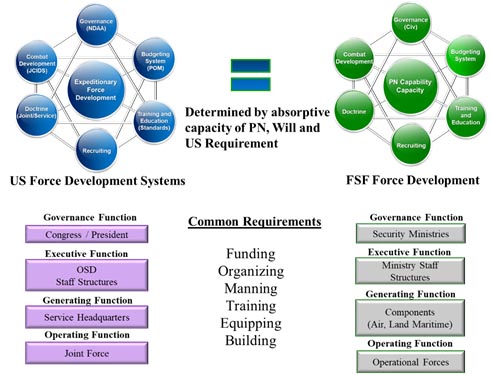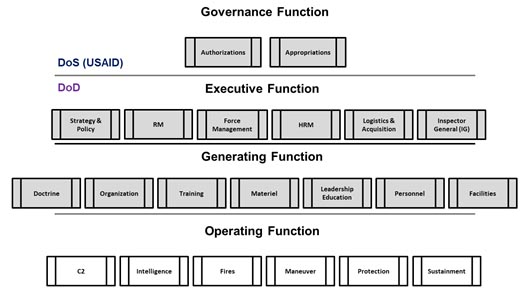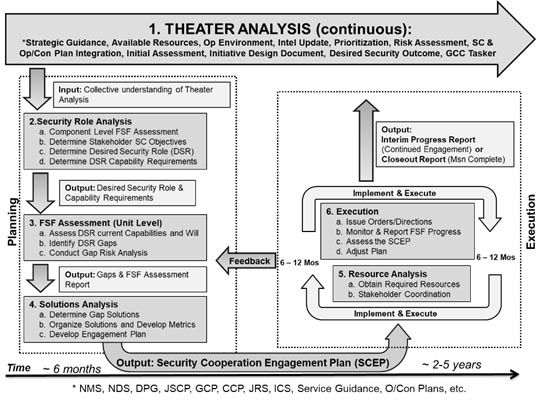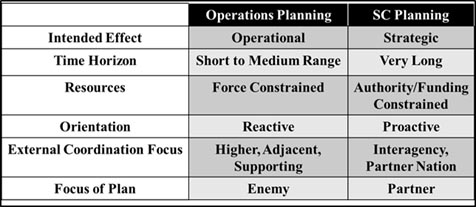Building Partner Capability and Capacity Post-NDAA 2017: A Practical Approach
Michael G. Murray II
“Strategy is a prudent idea or set of ideas for employing the instruments of national power in a synchronized and integrated fashion to achieve theater, national, and/or multinational objectives. Strategy can also be described as the art and science of determining a future state/condition (ends), conveying this to an audience, determining the operational approach (ways), and identifying the authorities and resources (time, forces, equipment, money, etc.) (means) necessary to reach the intended end state, all while managing the associated risk.”
-- JP 5.0, Joint Planning
The National Defense Authorization Act of 2017 (NDAA) sent ripples across the Department of Defense (DoD) Security Cooperation (SC) community. The NDAA of 2017 mandated significant changes in how Security Cooperation is to be planned, executed and accounted for. Subsequently, DoD issued DoD Instruction (DoDI) 5132.14 Assessment, Monitoring, and Evaluation Policy for the Security Cooperation Enterprise. The impacts of these two documents on the Security Cooperation enterprise are just beginning to be felt as they are transmitted down through the Geographic Combatant Commands (GCCs) and Services. Collectively the intent of the two documents, in conjunction with,other National and Strategic level guidance documents, casts the DoD into the role of building partners and allies that can help stabilize regions, address transregional threats, and posture the DoD for potential future fights. They accept the fact that the United States (US) is no longer going to fight alone. This means the US must select key partners to train, advise and assist to perform warfighting functions to some desired end or to achieve the access we require before future conflicts occur. Thus, it is accepted that part of the Strategy of the US is to build Partner Nation (PN) forces as part of our National Military Strategy. This paper will propose what it takes to accomplish this long-term strategic endeavor and, further consider how we do this in an appropriate manner by applying the JP 5-0 statement which introduced this discussion.
Setting the Stage
In studying how to build FSFs of PNs to achieve a desired future state, collectively we must first come to some common understanding. We must examine what it actually takes, understand what we are actually doing, and look through a historical or current example lens. We need to do so in order to determine the best way to proceed. Figure 1 below depicts a comparison of common systems, processes, and functions that must occur in order for a military to build readiness. In particular it articulates from top to bottom, that these people, systems, processes, and functions are interlinked. They are linked by different mechanisms such as orders, doctrine, policy, funding, etc.

Figure 1. US and Foreign Force Development Comparison
The DoD has many systems, programs, processes, and commands that create the US military. Examples such as the Joint Capabilities Integration Development System (JCIDS), Program Objective Memorandum process (POM), Joint Requirements Oversight Council (JROC), and many others work in conjunction with each other to produce forces that can execute the Unified Joint Task List (UJTL). The UJTL is a comprehensive list of military tasks at the strategic, operational, and tactical levels of warfare that equate to US military capabilities. The service components link to the UJTL through their service task lists and while it is impossible in this paper to describe all of the systems, processes and agencies that enable the US military to perform UJTL tasks to doctrinal standards; but it is pertinent that one understand that it is complicated, involves governance, touches all levels (strategic, operational, tactical), and is built upon the bedrock of standards based task performance. If we can agree that the Defense Readiness Reporting System (DRRS) captures US readiness for operations via standardized task-based criteria that chains and links all the way to the individual soldier, sailor, airman, or Marine then we can proceed.
The US is currently rebuilding PN forces, or Foreign Security Forces (FSF), in Afghanistan called the Afghan National Defense Forces (ANDSF) and I have chosen them to provide a case study to highlight issues that plague the DoD’s ability to build the ANDSF to achieve the desired end state. In the case of the ANDSF the DoD, alongside its interagency and coalition partners, have expended billions and intend to continue to do so. US and coalition partners currently have advisors working with the Afghan government, as well as in across the ANDSF working on the Governance, Executive, Generating, and Operational (G-EGO) functions required to enable the Afghan government to sustain and replicate the capabilities it requires to defeat the Taliban and stabilize the country. The G-EGO construct (Figure 2) is a method for categorizing advisor capabilities at different levels (figure 1), currently being proposed by the Joint Center for International Security Force Assistance (JCISFA).

Figure 2. G-EGO Construct for Advisors
However, it is rare for a US unit or individual tasked to train, advise, assist the ANDSF at any level to see the plan required to build the ANDSF that clearly delineates the desired strategic end state of the ANDSF, linked to tasks of any sort, or even roles. It is even rarer to see ANDSF doctrine, training standards at any level, POM processes, or other systems, processes, etc. that govern what the US would equate to an Expeditionary Force Development System (EFDS). This is not to say these things do not exist, it is only pointing out that the advisors executing “the plan” may not be succinctly linked to “the plan.” If the EFDS is what governs the US’ ability to produce forces capable of deploying to conduct all manner of operations, then it stands to reason that if we are building an ANDSF (a) capable of generating and employing a future force once we depart, then (b) there must be a plan that supports the build of a standards based ANDSF. That that plan would be singular in its end state, or as the Defense Institute for Security Cooperation Studies (DISCS) calls it, the “Desired Security Role (DSR).” Additionally, that that DSR would have chained and linked subordinate tasks, both collective and individual, supported by ANDSF doctrine of some sort.
In the case of a country, such as Afghanistan, the US is building the required capabilities to perform the DSR, or for simplicity sake let’s call it the Desired Security Outcome (DSO), and the capacity to perform the required governance-like functions to sustain and replicate those capabilities, from the governance level down to the tactical employment of units and across all man, train, equip functions. DSO will be used henceforth in this paper in order to provide flexibility of having multiple DSRs for separate arms of the ANDSF such as, the Afghan National Police (ANP), Afghan National Army (ANA), and others. DSO will equate to the desired future state as it relates to the Afghan Government and its ANDSF as a whole. In trying to achieve the DSO in Afghanistan, the US and its coalition partners have performed governance functions, assisted in organizing, manning, training, and equipping not only the government, but also its security forces. To be blunt, this is a form of nation building. Nation building has a bad connotation to some and is widely rejected by many within the US military and government. We must be honest with ourselves, while widely rejected by the military and government on one hand, one can argue that NDAA 2017 and its nested policies call for Nation Building investments into willing partners, prior to conflict (left of bang) , in order to increase the overall ability of coalitions to conduct warfare and, if we are going to work with allies and partners and inject money, advisors, equipment, and time to ensure they have the capacity to sustain and replicate warfighting capabilities, provide access, or perform to some defined level of interoperability, we are dabbling in Nation Building, plain and simple.
We must also admit that neither the US, nor its coalition partners, will commit forces or other personnel for multiple years to work on a plan to build a country’s FSF. In other words, none of our partners, nor the US, will routinely execute 3-5-year Permanent Change of Station (PCS) orders for advisors. Instead we will use rotational or episodic ad hoc forces to execute the advising actions required to build PN proficiency. Thus, it stands to logic that “The Plan” is paramount. Simple logic demands each rotation of US forces, or an individual augmentee that participates must have knowledge of the plan and must be trained to execute their assigned portions of the plan. That plan is informed by multiple assessments, and each effort (rotation) must be monitored and evaluated for success. The outcomes of each rotation must be fed back into the planning effort to adjust “The Plan” based on success or failure of a rotation. The plan itself must be a living and breathing document that is flexible and able to be adjusted based on rotational success/failure, changes in the environment, the political situation, or the fiscal environment. The plan must can be conditions based; those conditions are the successful execution of standards by the PN that equate to a capability and/or capacity to replicate capabilities. Just as the DoD does not measure itself in time-based readiness, nor should it measure PN progress using artificial time constraints, but rather standards based performance. Figure 3 depicts the full USMC SC Planning and Execution Cycle. This cycle takes into account the Defense Institute for Security Cooperation Studies (DISCS) planning process and expands upon it to include other required US planning processes that aid in developing a fully comprehensive plan to build capability, improve capacity, gain and measure access requirements, or fully measure and improve interoperability.

Figure 3. USMC SC Planning and Execution Cycle
Planning
SC planning is different from the inception of an idea that supports US military operational planning requirements for relationships, access, capabilities or capacities with PNs; whether rebuilding in Afghanistan or gaining access in some new country. Operational planning is enemy focused, whereas SC planning is friendly focused. SC planning helps the planner translate strategic guidance into actionable steps, incorporate objectives and interests of multiple stakeholders including the PN, compete for and efficiently utilize constrained resources, and demonstrate a Return on Investment (RoI) of committed resources. That RoI is linked to an Operational or Contingency Plan requirement, or some other US objective. Figure 4 shows discrete differences in SC planning from other types of operational planning and accounts for conceptual, functional and detailed planning requirements.

Figure 4. Operational Planning vs SC Planning
In order to move a country’s security forces from an assessed current state, to a desired end state requires a massive and comprehensive planning effort across multiple planning domains. The same could be said for determining and securing the actual access requirements the US requires in support of future operations. Once that plan is built, it requires that specific personnel are linked to the plan to execute it. Those personnel require absolute knowledge of the plan, they must be linked to one another to some degree. Their purpose must be to accomplish Unified Action to achieve the DSR.
Conclusion
Many studies by Rand, and other think tanks, have pointed out the failures of the US to build viable PN forces with the capability to sustain, replicate, and employ forces to some desired effectual end state. There are many reasons beyond the DoD’s ability to build PN forces that have impacts on why this has occurred such as PN will, ability, corruption, etc. This provides further evidence that the DoD should look at more effective and efficient methods to develop capable partners that will be of value to the US and PNs themselves. Perhaps those methods should be more focused on how we plan, what we plan, and who we apply to the plan to build a foreign capability or capacity.
Over the past two years, the DoD has focused on the workforce associated to SC endeavors. This paper suggests it is not only the workforce being applied, but must include the plans that are being developed coupled with how those plans will be implemented, how those plans are assessed, monitored and evaluated. Additionally, the forces applied to execute those plans in an episodic manner or even those DoD level advisors and their linkage to the plans. DoD has failed to recognize the comprehensive set of systems and processes required to build itself, that must be mirrored (to some degree) when attempting to build a PN capability, or capacity.
If DoD is serious about building viable partners, it must step back and reevaluate how it is currently viewing the future state of those partners and developing plans to move that partner towards the desired future state. SC is no longer a side mission, the mission in-between wars to shape, it has moved to the steady-state across the Range of Military Operations and is now a critical strategic tool that can provide us advantages over our adversaries if applied correctly. We must make these considerations and necessary changes rapidly, without emotion or clinging to current institutional rice bowls, if we are to compete with major adversaries who possess governmental structures that can outpace our ability to plan and execute SC-like operations with great effects.
